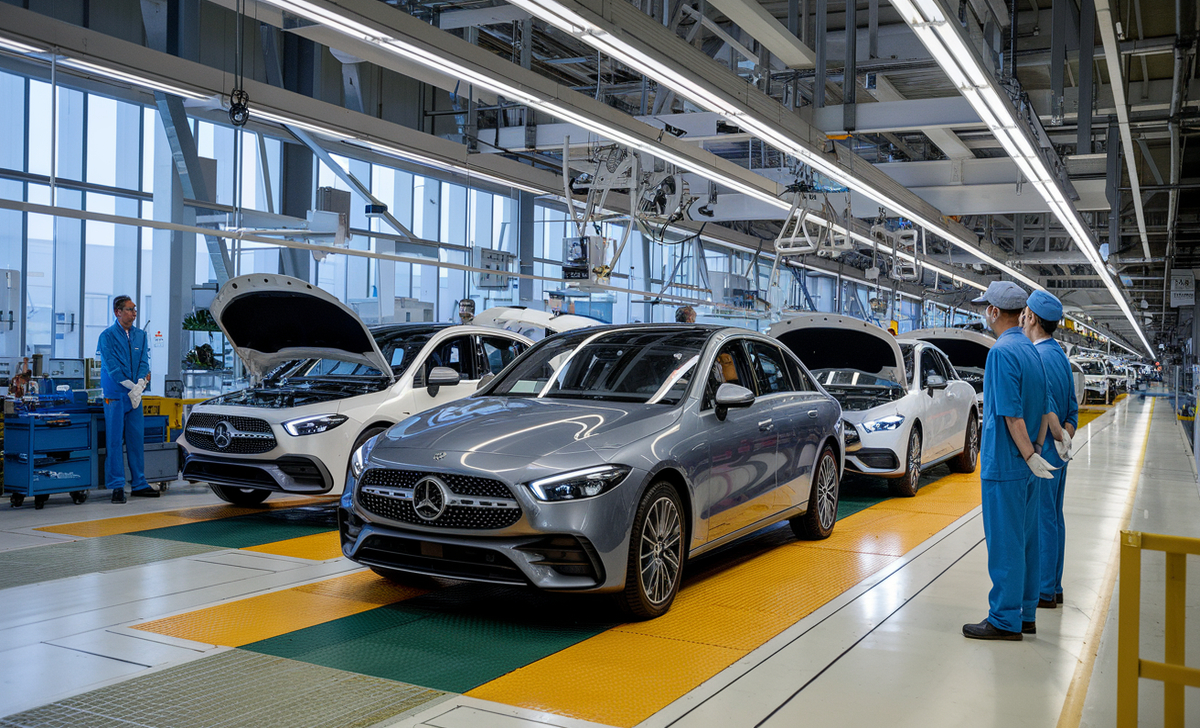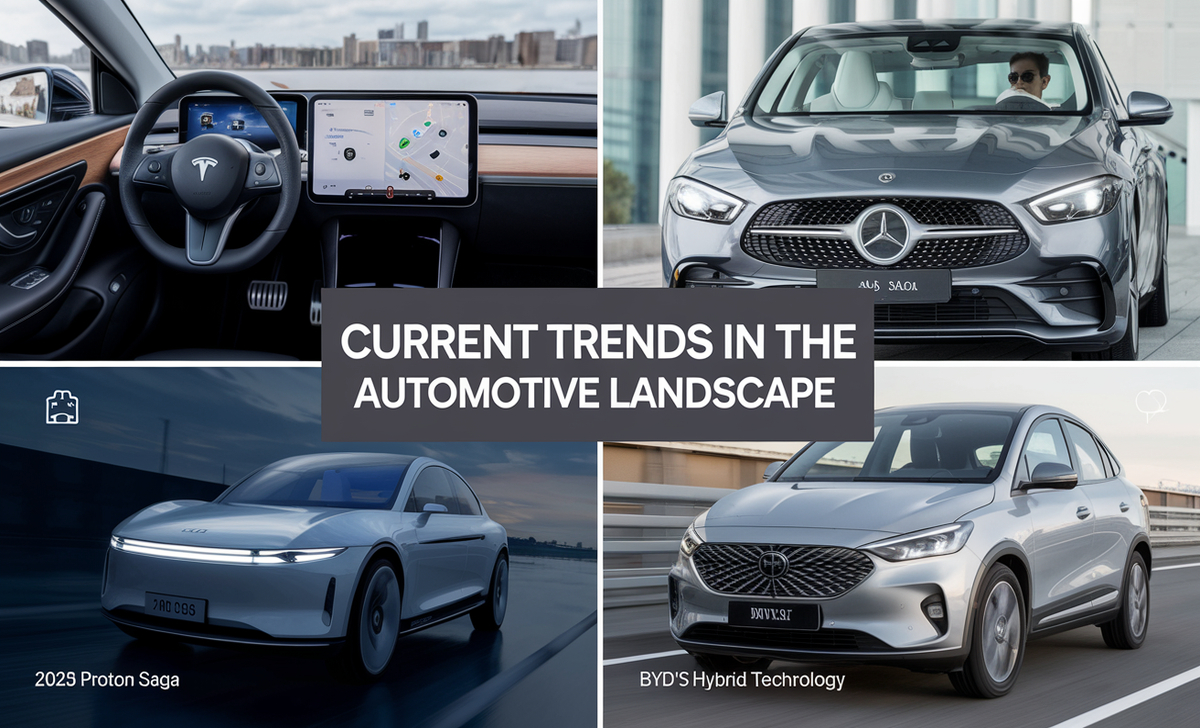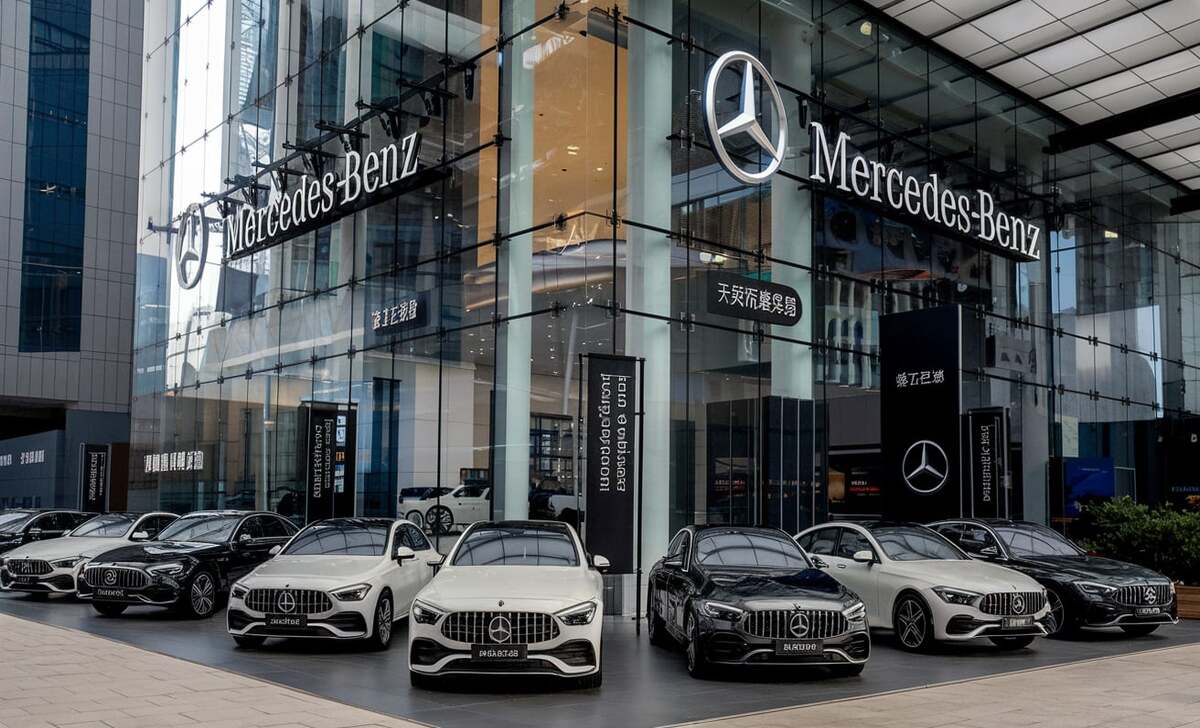Mercedes-Benz is cutting costs to stay profitable in a changing market. It is reducing staff, simplifying its model lineup, and improving supply chains.
The company also invests in digital tools and eco-friendly practices. By selling directly to customers, it keeps profits high while protecting its luxury image. This European automobile company is dealing with financial challenges. Demand is lower, competition is fierce, and global markets are changing.
They are trying their best to stay strong. Mercedes-Benz Group AG is improving logistics, cutting costs, and streamlining its supply chain. These efforts aim to boost performance in all divisions, including Cars, Vans, and Mobility.

Key Takeaways
- Mercedes-Benz Group AG is implementing cost-cutting measures to enhance profitability.
- Measures include workforce reduction, supply chain optimization, digital transformation, and a direct-to-consumer model.
- The company aims to reduce production costs by 10% by 2027 and 20% by 2030.
- Electric vehicle innovation, AI in manufacturing, and sustainable practices are key focus areas.
- Market positioning in China, Europe, and Asia-Pacific remains a priority.
Financial Challenges And Strategic Response

Market fluctuations have raised concerns about profits, with analysts predicting a 10% drop by 2025. Rising production costs , changing customer preferences, and supply chain issues are major factors. To address this, Mercedes-Benz is focusing on strategies to boost cash flow and reduce costs.
Roadmap For Cost Reduction (Until 2027)
- 2025: Initial cost reductions and digital transformation.
- 2027: 10% production cost reduction goal.
- 2030: 20% cost reduction goal achieved through automation and sustainability.
Mercedes-Benzs’ Key Cost Cutting Measures At A Glance

Mercedes-Benz is implementing comprehensive cost-cutting measures. The company aims to increase unit sales and stay strong in the automotive industry. These moves help ensure long-term success.
- Workforce Optimization: Reducing labor costs through automation and strategic downsizing.
- Streamlined Model Lineup: Focusing on high-margin models while discontinuing low-profit vehicles.
- Supply Chain Efficiency: Enhancing supplier partnerships and reducing logistical costs.
- Digital Transformation: Leveraging AI and software-driven solutions to minimize expenses.
- Sustainable Production Methods: Cutting energy costs while meeting green initiatives.
- Direct-to-Consumer Sales Model: Reducing dealership overhead through online sales channels.
1. Workforce Optimization

- Reduction in labor costs via automation.
- Voluntary redundancies and outsourcing for HR, finance, and procurement.
- Union negotiations to balance cost-cutting and employee retention.
Cost-cutting measures also extend to workforce adjustments. Mercedes-Benz Group is reducing personnel through voluntary redundancies and natural attrition. The company is outsourcing key functions. These are like finance, human resources, and procurement to external firms. Approaching to lower fixed costs.
Union investment talks are ongoing as the company works to restructure. Besides keeping employee morale high. The automotive industry has seen significant workforce cuts recently. Mercedes-Benz Group AG is adjusting its strategy to stay competitive.
2. Streamlined Model Lineup

- Focus on high-margin luxury models.
- Discontinuation of low-profit vehicles.
Mercedes-Benz is changing its vehicle design to use materials more efficiently. This new approach helps lower assembly costs. At the same time, it keeps the luxury and performance the brand is known for.
- Mercedes-Benz Cars,
- Mercedes-Benz Vans, and
- Mercedes-Benz Mobility.
Each division is regularly reviewed to ensure that cost-cutting measures support operational goals. Performance assessments help track progress and make adjustments as needed. This ensures that every department works efficiently and stays on target.
i) Advancements In Electric Vehicle Technology
With a focus on sustainability and innovation, Mercedes-Benz is investing heavily in electric vehicle (EV) technology. Daimler Truck and Mercedes-Benz Vans are spearheading developments in battery efficiency, charging infrastructure, and autonomous driving technologies to maintain a competitive edge.
ii) Integration Of AI In Manufacturing Processes
Artificial intelligence is transforming Mercedes-Benz AG’s manufacturing landscape. AI-driven analytics are improving production efficiency, minimizing waste, and streamlining quality control, ultimately contributing to cost reduction.
3. Production Costs And Supply Chain Optimization
One of the most significant areas of cost reduction for Mercedes-Benz AG is production costs. The company is working closely with European automakers and suppliers to lower material expenses.
By shifting some manufacturing from Germany to Hungary, where labor costs are lower, Mercedes-Benz Group can achieve substantial savings. Additionally, localizing production in China and the United States helps mitigate geopolitical risks and cater to Chinese consumers more effectively.
To further streamline its supply chain, Daimler Truck and Mercedes-Benz Vans are optimizing logistics operations. This move aims to enhance cash flow by reducing inefficiencies in procurement and transportation.
4. Luxury Vehicles And Market Share Strategy
With a renewed focus on luxury vehicles, Mercedes-Benz AG aims to maintain a high level of profitability despite weak demand in certain segments. The company is prioritizing premium news updates to reinforce its position as a leader in the Chinese market, where affluent consumers drive sales growth.
By maintaining an adjusted return strategy, Mercedes-Benz Bank is offering flexible financing solutions that appeal to high-end buyers, boosting unit sales and overall group revenue.
5. Financial Performance And Free Cash Flow Enhancement
Maintaining a strong net profit margin is essential for sustaining investor confidence. To achieve this, Mercedes-Benz Group AG is refining its approach to free cash flow management by divesting non-core assets, including real estate, to reinvest in its core automotive business.
Dieter Zetsche, a key figure in Mercedes-Benz’s financial strategy, emphasized the importance of mutual funds and diversified investments to ensure long-term stability. The company continues to adapt its financial strategies to remain resilient in volatile market conditions.
6. Level Performance Optimization
Mercedes-Benz Group AG is focused on optimizing level performance across its various divisions. By implementing advanced cost-reduction strategies, the company ensures that Mercedes-Benz Cars, Mercedes-Benz Vans, and Mercedes-Benz Mobility operate at peak efficiency. Cost-cutting measures are helping to streamline operations, boost cash flow, and maintain sustainable profitability.
i) Enhancing User Experience While Reducing Costs
Innovations in infotainment systems, interior materials, and aerodynamics contribute to cost-efficiency without compromising the premium experience Mercedes-Benz customers expect.
ii) Customizing Strategies For Various Market Segments
Mercedes-Benz China is tailoring strategies for Chinese consumers, adjusting pricing models, and enhancing luxury offerings to sustain its billion-euro market presence.
7. Sales Strategy And Cost Optimization In Mercedes-Benz Group
Mercedes-Benz Group AG is focusing on a strategic sales approach to maximize efficiency and profitability. By analyzing market trends and customer preferences, the company is refining its sales operations while implementing necessary cost-cutting measures. Sales performance across Mercedes-Benz Cars and Mercedes-Benz Vans continues to be closely monitored to ensure profitability aligns with cost-reduction objectives.
- Operational Efficiency Measures
Cost-cutting efforts include optimizing logistics, refining production processes, and improving data utilization to enhance level performance across all divisions.
- Long-Term Profitability Goals and Targets
Mercedes-Benz remains committed to achieving sustainable profit margins by 2030, leveraging strategic investments, personal finance solutions, and real estate management to reinforce free cash flow and group revenue.
- Dividend Strategy and Share Buyback Policy
Mercedes-Benz Group AG is maintaining a disciplined approach to dividends, ensuring stability for shareholders while allocating resources for future growth. By executing a well-timed share buyback strategy, the company aims to boost market confidence and support long-term investor returns.
Cost-Cutting Measures Impact On Daimler Mobility And Mercedes-Benz China

Daimler Mobility plays a crucial role in maintaining the company’s financial strength. With a focus on communication services and digitalization, Mercedes-Benz China is implementing smart mobility solutions to attract younger buyers. The brand is leveraging data analytics to enhance customer experience while managing costs effectively.
Fixed costs are being reduced across all business units, ensuring that operational efficiencies are sustained. As a result, the highest implied volatility and highest open interest in market performance indicate a strategic shift towards long-term profitability.
Current Trends In The Automotive Landscape

- Tesla’s 2025.2.6 Update and Its Implications
Mercedes-Benz closely monitors industry disruptors like Tesla, analyzing their software advancements and autonomous driving capabilities to remain competitive.
- Competitor Launches: 2025 Proton Saga and BYD’s Hybrid Technology
The emergence of new models, such as the 2025 Proton Saga and BYD’s advancements in hybrid vehicles, highlights the need for strategic adaptations to maintain market share.
Challenges Faced By Mercedes-Benz

- Navigating Market Dynamics in Europe: European automakers, including Mercedes-Benz Group, are facing stringent regulations, shifting consumer trends, and increasing sustainability requirements, necessitating continuous adaptation.
- Competition on Wall Street and in Asia-Pacific: As the automotive industry experiences rapid financial shifts, Mercedes-Benz Group AG is focusing on market positioning, investor confidence, and long-term financial stability.
The Role Of Moritz Kronenberger In Mercedes-Benz Group AG’s Cost-Cutting Initiatives
Moritz Kronenberger, a key financial strategist within Mercedes-Benz Group, has been instrumental in developing and implementing the company’s cost-cutting measures. His insights into personal finance, billion-euro investments, and level performance improvements have contributed to Mercedes-Benz AG’s resilience in an evolving automotive industry.
Mercedes-Benz China And The Growing Billion-Euro Market

The Chinese market remains a vital component of Mercedes-Benz AG’s global strategy. With a billion-euro revenue potential, Mercedes-Benz China is strengthening its local production capabilities while adjusting pricing models to enhance competitiveness. Personal finance solutions through Mercedes-Benz Bank are also playing a key role in sustaining strong sales performance in China.
Mercedes-Benz Group AG’s strategic cost-cutting measures ensure financial stability and sustained profitability. Through streamlined production, job restructuring, and enhanced market focus, the company is well-positioned to navigate the challenges of the modern automotive landscape.
Conclusion
Mercedes-Benz continues to honor the legacy of Carl Benz by innovating within the automotive industry. Through well-planned cost-cutting measures, the German automaker aims to secure its position as a global leader while navigating market challenges effectively.
Mercedes has been implementing strategic cost-cutting measures to enhance profitability without sacrificing its brand prestige. Mercedes-Benz is implementing cost-cutting measures to improve profitability, address weak demand, and maintain a competitive edge in the automotive industry amid intense competition.
As the automotive industry faces economic uncertainties, rising material costs, and the transition to electric vehicles (EVs), the German automaker has taken decisive steps to streamline operations, optimize resources, and maintain a competitive edge.
Frequently Asked Questions
1.Why Is Mercedes-Benz Implementing Cost-Cutting Measures?
Mercedes-Benz is implementing cost-cutting measures to improve profitability, address weak demand, and maintain a competitive edge in the automotive industry amid intense competition.
2.How Is Mercedes-Benz Reducing Production Costs?
Mercedes-Benz is reducing production costs by shifting manufacturing to lower-cost regions, working with suppliers, and optimizing logistics and supply chain operations.
3.What Workforce Changes Are Being Made At Mercedes-Benz?
Mercedes-Benz is making workforce changes by implementing job cuts through voluntary redundancy packages, outsourcing, and natural attrition to lower fixed costs and enhance efficiency.
4.How Does Mercedes-Benz’s Cost-Cutting Affect Luxury Vehicle Production?
Mercedes-Benz’s cost-cutting affects luxury vehicle production by maintaining high standards while optimizing costs, ensuring strong sales and brand prestige despite financial adjustments.
5.What Impact Do Cost-Cutting Measures Have On The Chinese Market?
Mercedes-Benz’s cost-cutting measures impact the Chinese market by localizing production and tailoring offerings to Chinese consumers, reinforcing its presence in a key market.
6.How Is Mercedes-Benz Improving Its Financial Performance?
Mercedes-Benz is improving its financial performance by optimizing costs, managing real estate assets, and leveraging mutual funds for diversified investments to enhance free cash flow.
7.What Role Does Daimler Mobility Play In Cost-Cutting?
Daimler Mobility plays a role in cost-cutting by focusing on digitalization and communication services to streamline operations and improve efficiency across all business units.
8.How Is Mercedes-Benz Managing Supply Chain Costs?
Mercedes-Benz manages supply chain costs through logistics enhancements and supplier collaboration. The company is reducing procurement costs and ensuring stable production efficiency.
9.What Does Cost-Cutting Mean For Mercedes-Benz’s Net Profit?
The cost-cutting means some strategic measures for Mercedes-Benz’s net profit. These measures help sustain net profit levels, ensuring the company remains financially strong despite fluctuating market conditions and competitive pressures.
10.How Does Mercedes-Benz Maintain Investor Confidence?
Mercedes-Benz maintains investor confidence by focusing on profitability, free cash flow, and long-term investment strategies, Mercedes-Benz reassures investors and strengthens its financial foundation.